Balasana(Child’s Pose): Health Benefits, How to do?- Variation
What Is Balasana (Shishusana)?
Balasana is derived from the Sanskrit word “Bala” which refers to a child and “asana” which represents pose. It is believed that performing this pose makes you go back to the memories of being in a womb because the posture of this asana is a lot similar to that of a baby’s when it’s in a mother’s womb.
It signifies surrender, humility, and honor. Few believe that this pose is done to tap into your inner child. While as an adult, you sometimes have to harden yourself to face the world, Balasana assists in reconnecting with your child self, allowing you to feel joyful.
Child’s Pose (Balasana) is yoga’s most important resting pose and it is a nice way to gently stretch various regions of your body. It’s a chance to stop what you are performing, reassess your pose, reconnect with your breath, and prepare yourself to move forward. In class, the teacher may allow resting in the child’s pose after a fast-paced vinyasa sequence, a long hold in a pose like Downward Facing Dog or Plank, or a try at a challenging inversion. It is a counter position for Cobra and other back extensions.
What are the Health Benefits of Balasana Yoga?
Let us now look into the advantages of child pose yoga or Balasana, which is a great sleeping asana.
- The balasana yoga or the asana aids release any tension in the chest. It is also why people trust yoga for good sleep.
- It relaxes the spine and back and enables people to trust yoga for good sleep.
- It relieves the stress felt by your shoulders and hands.
- The Child Pose is highly suggested to people who keep feeling dizzy.
- This sleeping asana pose, if done after a tiring workday or workout, can aid with relaxation and soothing of the muscles, ensuring good sleep.
- This pose helps relieve stress and feelings of anxiety. This is considered one of the top advantages of child pose.
- Since the Balasana Yoga for sleep bends the internal organs of your body, it assists in keeping them active, and therefore, supple.
- This stretch aids in the lengthening of the spine, and in keeping its natural alignment.
- When this yoga for better sleep pose is done with support on the head and the upper part of the body, the Child Pose can give ease from the pain felt in the lower back and the neck.
- It gives a good stretch to the legs, thighs, ankles, and hips.
- Performing this yoga before sleep aids lowers your blood pressure.
- By stretching out the entire body with the help of a pillow, the Balasana Yoga for sleep enhances blood circulation.
- It improves the quality of breathing, and thus, soothes the body as well as the mind. This is why yoga before sleep is a good habit. Many people trust yoga for better sleep.
- The muscles, tendons, and ligaments in your knees and legs gain the stretch they need through the Child Pose.
- This posture also helps to reduce lordosis posture
What are the Preparatory Poses for Balasana?
- Vajrasana
- Adho Mukha Svanasana
- Paschimottanasana
How to do Child’s Pose?
Put your hands and knees on the mat.
Expands your knees as wide as your mat, keeping the tops of your feet on the ground with the big toes touching.
Bring your abdomen to rest between your thighs and root your forehead to the ground. Relax the shoulders, eyes, and jaw. If it is not comfortable to put the forehead on the floor, put it on a block or two stacked fists. There is an energy point at the center of the forehead in between the eyebrows activates the vagus nerve and supports a “rest and digest” response. Finding a comfortable place for the forehead is key to gaining this soothing advantage.
There are various possible arm variations. You can stretch your arms in front of you with the palms toward the ground or bring your arms back on either side of your thighs with the palms facing upwards. These are the most common alternatives. But you can also, stretch the arms forward with palms facing towards the roof for a shoulder release, or try flexing the elbows so that the palms touch and rest the thumbs at the back of the neck. In this pose inch the elbows forward.
Do whichever experience is more comfortable for you. If you’ve been performing a lot of shoulder work, the second option feels nice.
Hold the pose as long as you like, eventually reconnecting with the steady inhales and exhales of your breath.
How to do Balasana (Child’s Pose) by watching a video?
What are the Follow-up Poses for Balasana?
- Pigeon Pose
- Tri Pada Adho Mukha Svanasana
- Frog Pose I
What are the Beginners’ tips for Balasana?
There are certain things you need to know about Balasana:
- A child’s pose is about being comfortable and rested as well as improving flexibility in the hips and back. S
- Many people observe it as more comfortable to take the knees wider (to the width of a yoga mat). This also forms more space if you have a larger belly or breasts.
- Use props or stack your fists to support your forehead if it doesn’t reach the ground comfortably.
- Use padding under your knees or ankles if you want to.
What are the Modifications and Variations for Balasana?
- You can choose to maintain the knees together instead of separating them if that is more comfortable for you. Likewise, you can curl the toes under if it is painful to have the feet flat, or put a rolled towel under your shins to take the stress off of your ankles.
- You can put a yoga blanket or a towel underneath the knees for padding and added support.
- For a restorative variation, put a bolster or pillow under your stomach or chest and assume the pose for up to 10 minutes.
- You can get a deeper stretch of the hips by expanding your knees wider.
- Rabbit pose – If need be, and during pregnancy, the knees can be wide. The arms may be extended forward in front of the head. It is practiced in Bikram Yoga, has the tailbone raised until the thighs are vertical and the head and arms pointing back towards the feet, forming an intense flexion of the spine.
- Ananda Balasana or “Happy Baby Pose” is an inverted shape of a Child’s Pose; it has the body on the back, the thighs alongside the body, the knees flex and the hands grab the toes.
- Uttana Shishosana or “Extended Puppy Pose” stretches forwards from all fours until the forehead and forearms are resting on the ground and the thighs are vertical, giving a posture intermediate between Balasana and Adho Mukha Shvanasana (Downward Dog Pose).
What are the Types of Balasana?
There is only one type of balasana :
Ananda Balasana (Happy Baby Pose )
What Is Happy Baby Pose?
Also Known as Dead Bug Pose.
The happy baby pose is a passive, restorative hip opener often performed alone or near the end of a yoga class as a part of a cool down right before Savasana. In Sanskrit, the happy baby pose is called Ananda Balasana, with Ananda refers “joy or bliss” and Bala refers to “child.” Some yogis refer to the pose as the dead bug pose because of how the hands and feet are suspended in the air during this pose.
This asana assists yogis open the hips in a safe and restorative way, releasing any tension that may be stored therefrom exercising, walking, or sitting in a car or at a desk for long periods. The pose can gently re-align the spine, and give a therapeutic stretch to the groin and inner thighs, and a deep stretch to the hamstrings, depending on how much you choose to flex your legs or straighten them.
Benefits of performing Happy Baby Pose:
- With this posture, you open the hips and allow a stretch to your inner thighs, hamstrings at the back of the thighs, and groin.
- It releases the sacrum and the back. You may observe one hip is tighter than the other and then know which to target for a better mobility and flexibility.
- In yoga, this move is suggested for relief of stress and fatigue, to calm and center you.
- You have probably watched a baby hold its toes and play with them, perhaps envying that simple movement and sense of wonder.
- Grasping your toes as a baby does bring you back to the flexible spine you had as a baby.
Preparatory Poses for Ananda Balasana :
- Balasana (Child’s Pose)
- Virasana (Hero Pose)
How to do Ananda Balasana?
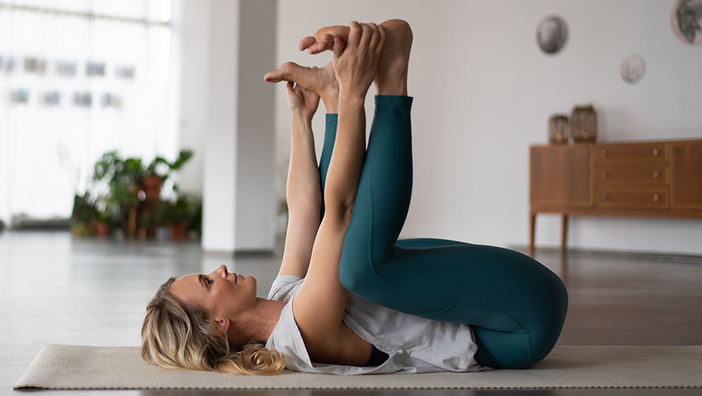
You need an exercise mat or a firm, padded surface. You may need to support your neck with a small pad, pillow, or folded blanket.
Lie in a supine position and find a neutral spine position where the natural curves of your spine are there but not exaggerated.
Draw your knees toward your chest. As you bring your knees up, let your hip sockets soft so that your legs come up but your hips stay down. Maintain your neutral spine with your tailbone on the mat.
Flex your feet and show the soles of your feet to the roof.
Interlace your first two fingers around your big toes and pull lightly down. Your feet stay flat to the roof but your hips release permitting your knees to come closer to your chest as you relax. You can also draw your hands up to the outside of the foot and grab the foot around the arch.
Take the time and breathe deeply. Enjoy the mild stretch in your hamstrings.
Let your back relax into the ground—don’t push it down, just permit it to release naturally. Be a happy baby.
Follow-up Poses for Ananda Balasana :
- Adho Mukha Svanasana (Downward-Facing Dog)
Beginner’s Tips for top Happy Baby pose:
here’s how to keep things soft and supportive:
- Keep your shoulders stuck to the mat. Raising your shoulders can be difficult on your spine. If they’re raising off the mat, try grabbing your ankles or shins.
- Keep your head grounded. Raising your head can lead to neck strain or pain. If you’re having a difficult time keeping your head down, try utilizing a rolled blanket or towel underneath your neck. You can also try grasping your ankles or shins instead of your feet or using a yoga strap.
- In this posture, there’s no need to push your body or work hard — you’ll gain the most benefits by just relaxing in it.
- If you can’t easily grab your feet with your hands, try grasping each foot with a yoga strap looped around the middle arch.
Happy Baby modifications :
Happy Baby modifications can make the posture more accessible and comfortable.
Use a yoga strap
Happy Baby Posture is all about getting down-to-earth. If your head, neck, or shoulders are lifting off the floor or it’s difficult to grasp your feet, and try using a yoga strap around the arch of each foot.
Use your elbows to separate your knees
If your knees keep wanting to kiss, try using your elbows to split them. The added pressure will assist you to slip into the proper position and maximize the stretch.
Hold one leg at a time
Lifting one leg at a time can aid you gently easing into the stretch, especially if it’s hard to keep your pelvis, neck, head, or shoulders on the floor. It can also aid you to isolate each leg to balance out the flexibility between your limbs.
- Reach for your ankles or shins. If your feet are too far away, grab for your shins or ankles instead.
- Use a folded blanket. A common error that beginners make is to raise the head and neck off the mat, creating tension in the upper back. If you have a neck injury or just need more support, put a folded blanket under your head to keep the back of the neck long and release any tension in the torso during this pose.
- Peace fingers around the big toes. Instead of grasping the outer edges of the feet, you can make “peace fingers” and cover them around your big toes. This move gives you a firmer grip than grasping the outsides of the feet and offers you more leverage to pull your legs towards you and expand your hips more.
- Hands grab the inner parts of the feet. You can also reach for the inner edges of the feet and see how they experience on your body.
Common Mistakes while Ananda Balasana:
To get the most out of this exercise, prevent these errors.
Shoulders Raised
Try to keep the position contained so the legs stay fairly parallel and the shoulders stay settled on the ground. This can be hard if you have very tight hips. If you find your shoulders must lift from the mat, modify where you place your hands (such as at the ankles or shins) so your chest remains open and your shoulders stay on the mat.
Chin Lifted
If your neck is not in contact with the mat, your chin will be lifted, which places your neck at risk of strain. Often this is caused by lack of flexibility so you are straining to grasp your feet with your hands. Instead, grab your ankles or shins.
Safety and Precautions for Ananda Balasana:
If you are pregnant or if you have a knee injury or neck injury, you shouldn’t do the Happy Baby exercise.
Consult your instructor for modifications or alternative exercises.
If you feel pain at any time during this exercise, release the pose.
Contraindications for Ananda Balasana:
- Pregnancy
- Knee injury
- Neck injury
What is a Common Mistake you can’t do while Balasana?
- Your neck should pause in a neutral position. If you find you are flexing your neck, use a yoga block, pillow, or another prop to keep pressure off your neck.
- Place your arms by your side if you have a shoulder injury.
- If you feel pain during the pose at any time, then ease out of it to avoid injuries.
What are the Precautions and Contraindications for Balasana Yoga Pose?
Here are a few things to keep in mind while doing the Balasana Yoga:
- When placing the head on the ground on the mat you feel some problem or find it uncomfortable, then you can use a pillow or a cushion for support.
- If you are suffering from diarrhea, then prevent yoga before sleep as it massages the digestive tract and generates pressure on the bowels.
- If you have injuries in your legs or knee issues, then avoid getting into this sleeping asana.
- If you are a patient with hypertension, then this yoga before sleep must be prevented.
- Although yoga for better sleep has been proven, you may need to see a doctor if your insomnia isn’t decreased by practicing sleeping asanas.
- Pregnant women can’t perform this yoga pose, though it gives pressure on their stomachs.

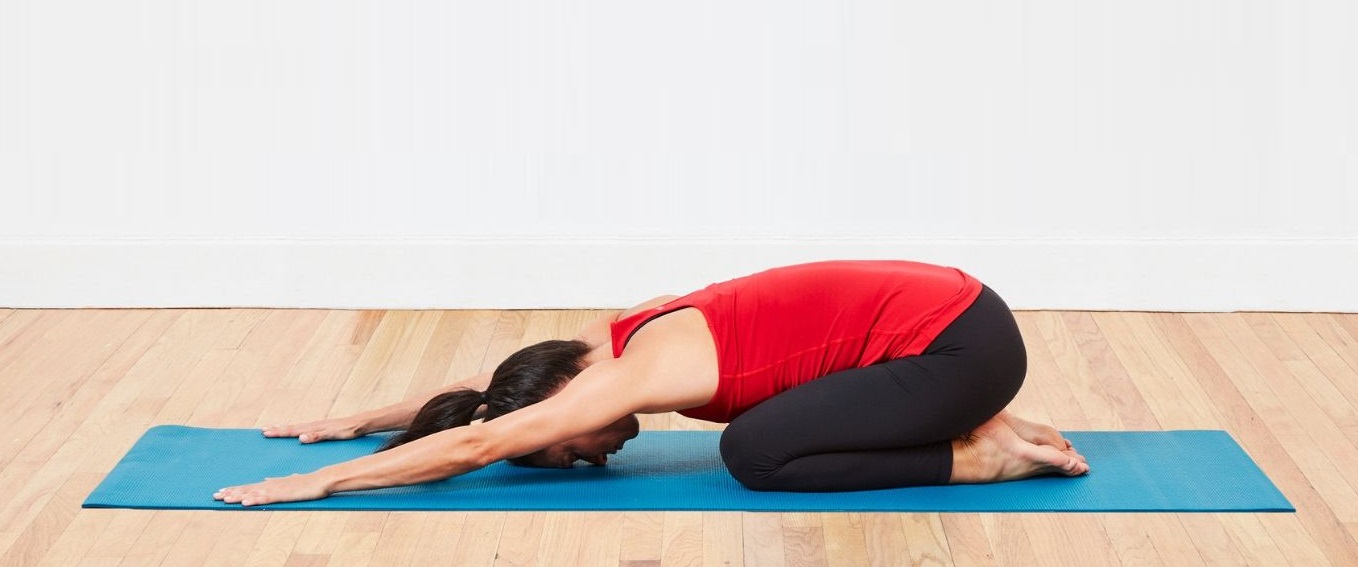
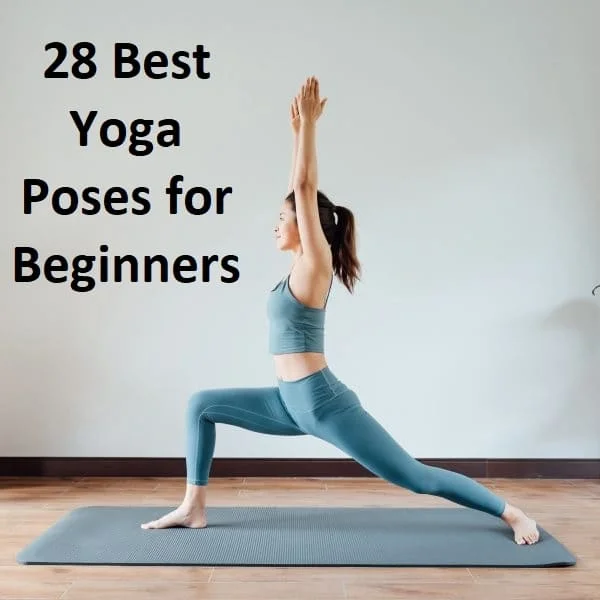
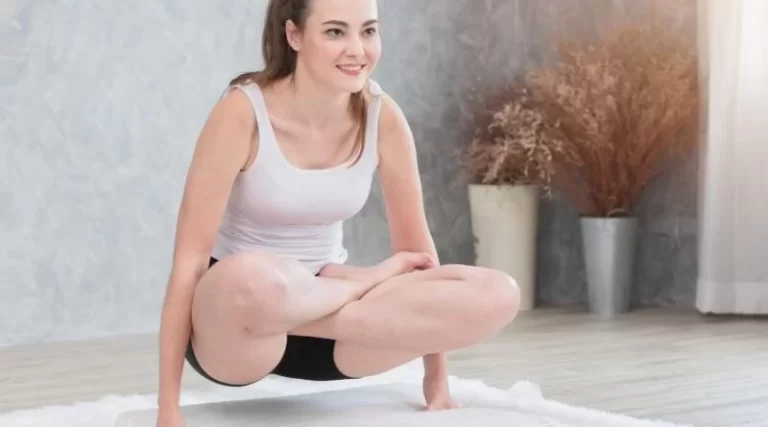
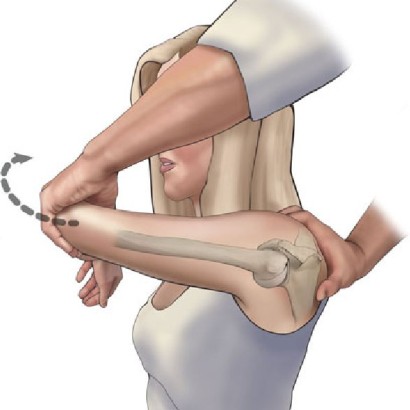
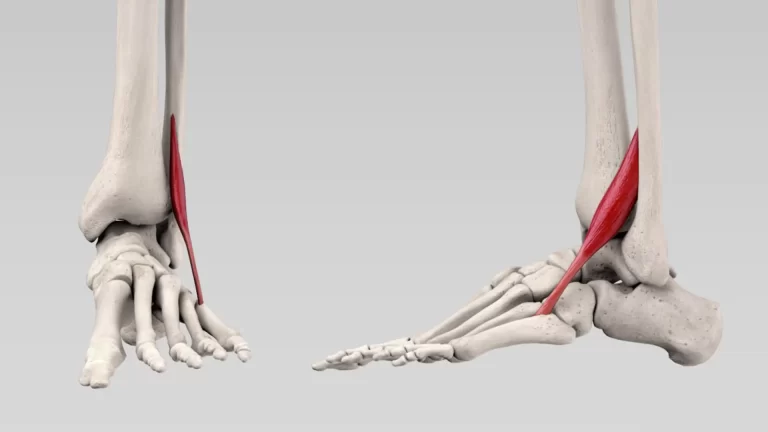
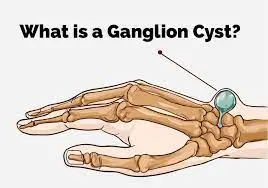
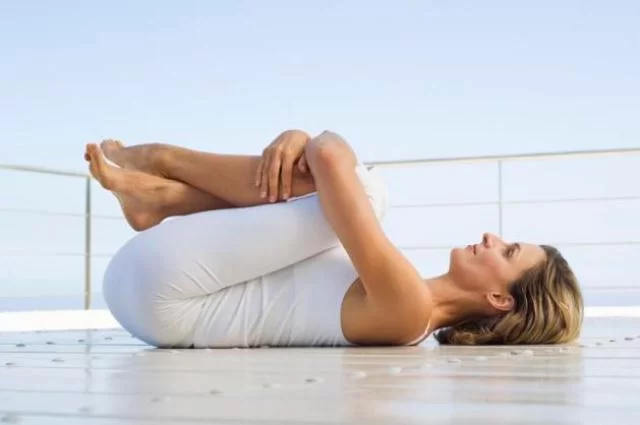
11 Comments